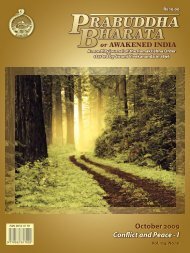P
PB Cover July 2011.indd - Advaita Ashrama
PB Cover July 2011.indd - Advaita Ashrama
- No tags were found...
You also want an ePaper? Increase the reach of your titles
YUMPU automatically turns print PDFs into web optimized ePapers that Google loves.
Mexico Rising: The Gods Are Alive 41<br />
his forehead. Their rays joined at one point, and<br />
slowly the blazing concentration of light took<br />
the form of a mother goddess. The gods prayed<br />
to her and worshipped her with praise, ornaments,<br />
and weapons. ‘Victory to the Mother,’<br />
they shouted as the goddess killed the demons<br />
and restored peace and tranquillity.<br />
This story from the Chandi, India’s famous<br />
scripture, has a deep meaning. The demons to<br />
be killed are not only outside ourselves, they<br />
also reside within us as anger, lust, and greed.<br />
Lust for more power and more wealth is a sign<br />
of materialistic thought. There never is enough<br />
money, never enough power to satiate human<br />
desire.<br />
Greatness may be forgotten for some time<br />
but, sooner or later, it will rebound. Will Mexico<br />
be able to revive its ancient traditions and<br />
make them relevant for the present and future?<br />
Many years have gone by since I first visited<br />
Mexico City, but I still clearly remember the<br />
voice that taught me the ancient way—by situation<br />
rather than through books. I learned<br />
through experience and am grateful that I was<br />
introduced to Our Lady of Guadalupe through<br />
the ancient Mother Coatlicue. I humbly placed<br />
red roses at her feet.<br />
The gods are waiting for worship. There is<br />
room for all gods and goddesses. In India there<br />
are so many temples dedicated to different<br />
manifestations of the same mother goddess.<br />
Churches exist side by side with Hindu temples<br />
and Muslim mosques. Sri Ramakrishna used<br />
to say: ‘God can be realized through all paths.<br />
All religions are true. … Devotees call on God<br />
alone, though by different names. They call<br />
one Person only. God is one, but His names are<br />
many.’ The Divine Mother Coatlicue is ready to<br />
come out of the museum, ready to nurture and<br />
protect her children living in the holy land of<br />
Mexico.<br />
P<br />
PB July 2011<br />
(Continued from page 493)<br />
2. To understand the process of kāyasiddhi see A<br />
Brief History of Tantra Literature, 26.<br />
3. A Brief History of Tantra Literature, 454; see also<br />
Swami Harshananda, A Concise Encyclopaedia<br />
of Hinduism, 3 vols (Bangalore: Ramakrishna<br />
Math, 2008), 2.311–12.<br />
4. For khecarī mudrā see Hatha Yoga Pradipika,<br />
3.32–53; Gheranda Samhita, ‘Tritiyopadesha’,<br />
mudrā prakaraṇa, verses 25–32. Cf. Shritantraloka,<br />
5.361–2.<br />
5. For vajrolī mudrā see Hatha Yoga Pradipika,<br />
3.82–9; Gheranda Samhita, verses 45–8.<br />
6. For plāvini kumbhaka see Hatha Yoga Pradipika,<br />
2.70–8.<br />
7. For details on the awakening of the kundalini<br />
see Hatha Yoga Pradipika, 3.97–123; Gheranda<br />
Samhita, ‘Tritiyopadesha’, mudrā prakaraṇa,<br />
verses 49–60. See also Arthur Avalon, The Serpent<br />
Power (Madras: Ganesh, 1958); V G Rele,<br />
The Mysterious Kundalini, (Bombay: D B Taraporewala,<br />
1929); Gopi Krishna, Kundalini: Path<br />
to Higher Consciousness (Delhi: Orient Paperbacks,<br />
1976); and Mary Scott, Kundalini in the<br />
Physical World (London: Routledge and Kegan<br />
Paul, 1983).<br />
8. For the specific legend relating to Matsyendranatha<br />
and Gorakhanatha see Georg Feuerstein,<br />
The Yoga Tradition, Its History, Literature,<br />
Philosophy and Practice (Delhi: Bhavana Books<br />
and Prints, 2002), 512.<br />
9. George Weston Briggs, Gorakhnāth and the<br />
Kanphaṭa Yogīs (Calcutta: YMCA Publishing<br />
House, 1938), 228–50.<br />
10. Benjamin Walker, Encyclopedia of Esoteric Man<br />
(London: Routledge and Kegan Paul, 1977), 77.<br />
11. See Hatha Yoga Pradipika, Chapter 4.<br />
12. Saiyid Athar Abbas Rizvi, A History of Sufism in<br />
India, 2 vols (Delhi: Munshiram Manoharlal,<br />
1983), 1.332–3.<br />
13. See Hatha Yoga Pradipika, 1.61–6.<br />
14. Cf. Shritantraviloka, 11.33–8.<br />
15. Census of India 1961, 5: Gujarat Part VII-B, Fairs<br />
and Festivals (Superintendent of Census Operations,<br />
Gujarat), 217–18. For sites and Yogashramas<br />
of Gorakhanatha in Nepal see Kalyāṇa<br />
(Yogānka) (Gorakhpur: Gita Press, 1935), 784.<br />
16. See Hatha Yoga Pradipika, 1.56–7.<br />
501
















